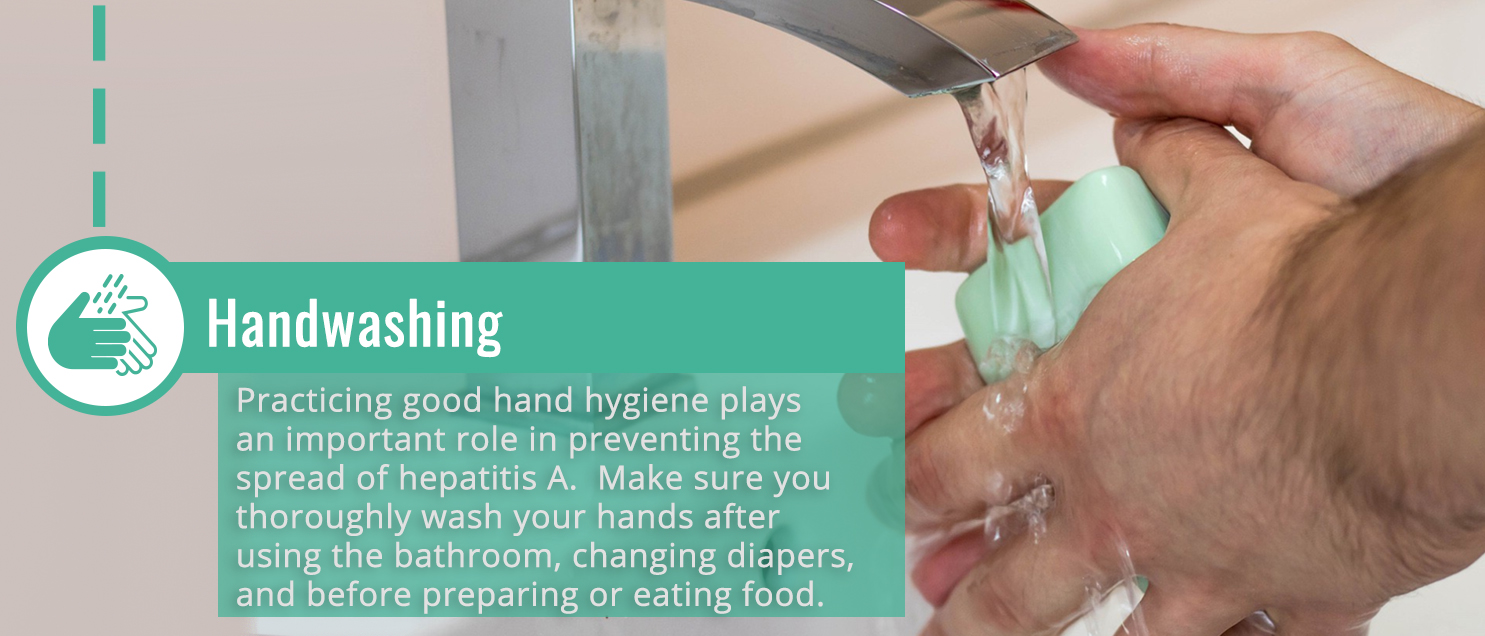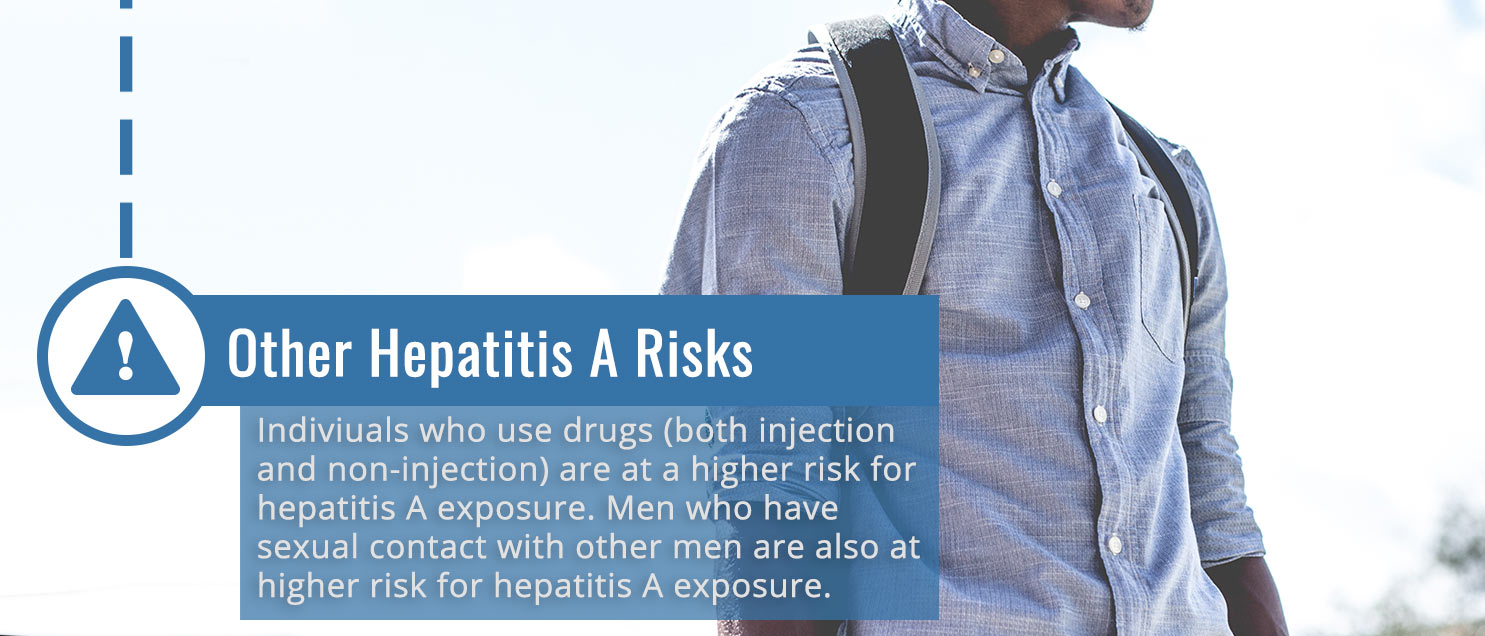Hepatitis A
- Outbreak Information
- Data and Statistical Reports
- Immunization Schedules
- Fact Sheets
- Information for providers
Overview
What is hepatitis A?
Hepatitis A is a highly contagious liver infection caused by the hepatitis A virus. It can range from a mild illness lasting a few weeks to a severe illness lasting several months. Hepatitis A usually spreads when a person unknowingly ingests the virus from objects, food, or drinks contaminated by small, undetected amounts of stool from an infected person.
How serious is hepatitis A?
Most people who get hepatitis A feel sick for several weeks, but they usually recover completely and do not have lasting liver damage. In rare cases, hepatitis A can cause liver failure and death; this is more common in people older than 50 and in people with other liver diseases.
Transmission / Exposure
How is hepatitis A spread?
Hepatitis A usually spreads when a person unknowingly ingests the virus from objects, food, or drinks contaminated by small, undetected amounts of stool from an infected person. Hepatitis A can also spread from close personal contact with an infected person such as through sex or caring for someone who is ill.
Contamination of food (this can include frozen and undercooked food) by hepatitis A can happen at any point: growing, harvesting, processing, handling, and even after cooking. Contamination of food or water is more likely to occur in countries where hepatitis A is common and in areas where there are poor sanitary conditions or poor personal hygiene. In the United States, chlorination of water kills hepatitis A virus that enters the water supply. The Food and Drug Administration (FDA) routinely monitors natural bodies of water used for recreation for fecal contamination so there is no need for monitoring for hepatitis A virus specifically.
Who is at risk for hepatitis A?
Although anyone can get hepatitis A, in the United States, certain groups of people are at higher risk, such as:
- People with direct contact with someone who has hepatitis A
- Travelers to countries where hepatitis A is common
- Men who have sexual contact with men
- People who use drugs, both injection and non-injection drugs
- Household members or caregivers of a recent adoptee from countries where hepatitis A is common
- People with clotting factor disorders, such as hemophilia
- People working with nonhuman primates
I think I have been exposed to hepatitis A. What should I do?
If you have any questions about potential exposure to hepatitis A, call your health professional or your local or state health department. If you were recently exposed to hepatitis A virus and have not been vaccinated against hepatitis A, you might benefit from an injection of either immune globulin or hepatitis A vaccine. However, the vaccine or immune globulin are only effective if given within the first 2 weeks after exposure. A health professional can decide what is best based on your age and overall health.
What is postexposure prophylaxis (PEP)?
Postexposure prophylaxis (PEP) refers to trying to prevent or treat a disease after an exposure. For hepatitis A, postexposure prophylaxis is an injection of either immune globulin or hepatitis A vaccine. However, the vaccine or immune globulin are only effective in preventing hepatitis A if given within the first 2 weeks after exposure.
If I have had hepatitis A in the past, can I get it again?
No. Once you recover from hepatitis A, you develop antibodies that protect you from the virus for life. An antibody is a substance found in the blood that the body produces in response to a virus. Antibodies protect the body from disease by attaching to the virus and destroying it.
How long does hepatitis A virus survive outside the body?
The hepatitis A virus is able to survive outside the body for months. High temperatures, such as boiling or cooking food or liquids for at least 1 minute at 185°F (85°C), kill the virus, although freezing temperatures do not.
Symptoms
What are the symptoms of hepatitis A?
Older children and adults typically have symptoms. If symptoms develop, they can appear abruptly and can include:
- Fever
- Fatigue
- Loss of appetite
- Nausea
- Vomiting
- Abdominal pain
- Dark urine
- Clay-colored stools
- Joint pain
- Jaundice (yellowing of the skin and eyes)
Most children younger than age 6 do not have symptoms when they have hepatitis A. When symptoms are present, young children typically do not have jaundice but most older children and adults with hepatitis A have jaundice.
How soon after exposure to hepatitis A will symptoms appear?
If symptoms occur, they usually start appearing 4 weeks after exposure, but can occur as early as 2 and as late as 7 weeks after exposure. Symptoms usually develop over a period of several days.
How long do hepatitis A symptoms last?
Symptoms usually last less than 2 months, although some people (10%–15%) with hepatitis A can have symptoms for as long as 6 months.
Can a person spread hepatitis A without having symptoms?
Yes. Many people, especially children, have no symptoms. In addition, a person can transmit the virus to others up to 2 weeks before symptoms appear.
Diagnosis / Treatment
How will I know if I have hepatitis A? How is hepatitis A diagnosed?
A doctor can determine if you have hepatitis A by discussing your symptoms and taking a blood sample.
Prevention / Vaccination
Can hepatitis A be prevented?
Yes. The best way to prevent hepatitis A is through vaccination with the hepatitis A vaccine. To get the full benefit of the hepatitis A vaccine, more than one shot is needed. The number and timing of these shots depends on the type of vaccine you are given. Practicing good hand hygiene – including thoroughly washing hands after using the bathroom, changing diapers, and before preparing or eating food – plays an important role in preventing the spread of hepatitis A.
Who should get vaccinated against hepatitis A?
The Advisory Committee on Immunization Practices (ACIP) recommends hepatitis A vaccination for the following people:
- All children at age 1 year
- Travelers to countries where hepatitis A is common
- Family and caregivers of adoptees from countries where hepatitis A is common
- Men who have sexual encounters with other men
- Users of recreational drugs, whether injected or not
- People with chronic or long-term liver disease, including hepatitis B or hepatitis C
- People with clotting-factor disorders
- People with direct contact with others who have hepatitis A
- Any person wishing to obtain immunity (protection)
Information for Providers
- CDC Information for Providers
- Communicable Disease Investigation Reference Manual
- State Public Health Lab
Outbreak Information
Missouri Hepatitis A Outbreak Information – Last Updated March 14, 2020
Since September 2017, the Missouri Department of Health and Local Public Health Agencies (LPHAs) have received increased reports of hepatitis A linked to an ongoing outbreak in Missouri. As of March 14, 2020, 697 cases of hepatitis A virus infection have been linked to the outbreak. No common sources of food, beverages, or drugs have been identified as a potential source of the infection. Transmission appears to be through direct person-to-person spread. Based on current information, persons who use injection and non-injection illicit drugs are at increased risk for hepatitis A during this outbreak. Several other states are also experiencing similar outbreaks of hepatitis A. Public health officials in Missouri continue working to identify cases and their contacts, provide education, and to provide vaccination of close contacts to cases and others identified to be at increased risk for hepatitis A infection.
Hepatitis A is a highly contagious liver infection caused by the hepatitis A virus. It can range from a mild illness lasting a few weeks to a severe illness lasting several months. Although rare, hepatitis A can cause death in some people. Hepatitis A usually spreads when a person unknowingly ingests the virus from objects, food, or drinks contaminated by small, undetected amounts of stool from an infected person. If symptoms occur, they usually appear two to seven weeks after exposure. Symptoms usually develop over a period of several days, and may include the yellowing of the skin or whites of the eyes, abdominal pain, nausea or diarrhea. The best way to prevent hepatitis A is to get the hepatitis A vaccine. In addition, it is important to protect yourself and others from hepatitis A by thoroughly washing hands after using the bathroom, changing diapers, and before preparing or eating food.
Missouri Hepatitis A Outbreak-Associated Cases, Hospitalizations and Deaths as of March 14, 2020
| Cases | Hospitalizations | Deaths |
|---|---|---|
| 697 | 403 (58%) | 2 |
*The data provided are provisional and subject to change.
| COUNTY | Total Cases |
|---|---|
| AUDRAIN | 2 |
| BARTON | 1 |
| BUCHANAN | 1 |
| BUTLER | 108 |
| CALLAWAY | 5 |
| CAMDEN | 3 |
| CAPE GIRARDEAU | 7 |
| CARTER | 21 |
| CHRISTIAN | 7 |
| CRAWFORD | 21 |
| DALLAS | 6 |
| DENT | 1 |
| DOUGLAS | 6 |
| DUNKLIN | 15 |
| FRANKLIN | 89 |
| GASCONADE | 2 |
| GREENE | 111 |
| HOWELL | 50 |
| JASPER | 9 |
| JEFFERSON | 7 |
| JOPLIN | 23 |
| LACLEDE | 17 |
| LAWRENCE | 2 |
| MADISON | 1 |
| MISSISSIPPI | 1 |
| NEW MADRID | 3 |
| NEWTON | 4 |
| OREGON | 12 |
| OZARK | 4 |
| PEMISCOT | 8 |
| PLATTE | 1 |
| PHELPS | 3 |
| POLK | 2 |
| REYNOLDS | 6 |
| RIPLEY | 11 |
| SCOTT | 35 |
| SHANNON | 2 |
| ST. CHARLES | 6 |
| ST. FRANCOIS | 8 |
| ST. LOUIS | 5 |
| ST. LOUIS CITY | 8 |
| STE. GENEVIEVE | 4 |
| STODDARD | 40 |
| STONE | 1 |
| TEXAS | 5 |
| VERNON | 2 |
| WARREN | 1 |
| WAYNE | 6 |
| WEBSTER | 1 |
| WRIGHT | 2 |
| GRAND TOTAL | 697 |




